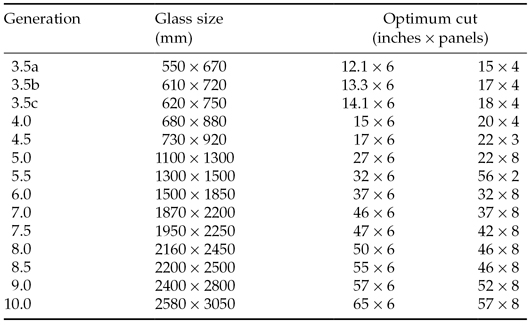25
Glass, Panels, and Modules
All the science and technology are now in place for construction of the final product, the liquid crystal display. The manufacturing process begins with the glass substrate, which is provided by primarily two companies, America’s Corning and Japan’s Asahi.
Glass Generations
It has become an LCD industry convention to mark progress by glass substrate size in generational increments, and the plants that manufacture the LCD panels are so designated as nth-generation plants. The table below lists the generation, sizes, and representative optimum LCD panel “cuts” from the glass substrate. The earliest glass sizes were for digital watches, calculators, and small computers, and were manufactured in what is today called the first- to third-generation plants; the processing technology was relatively rudimentary and quite unlike the large-scale, automated manufacturing in later generation fabrication plants (“fabs”), so they are not included in the table. The table shows the tremendous increase in glass sizes [1].

An example of an 8.5-generation AUO glass panel is shown in Figure 25.1; from the photograph the scale of the glass size is apparent, a more than two meters screen size can certainly begin to compare with movie theater screens.
Figure 25.1 8.5-generation glass panel.
Courtesy of AU Optronics.
The 3.5- and 4.0-generation fabs built by Japanese companies ...

